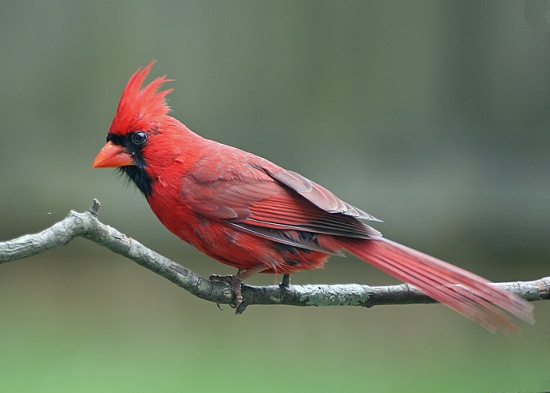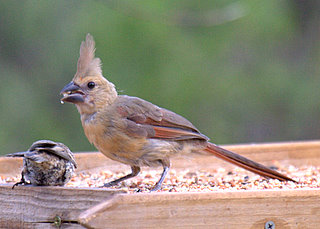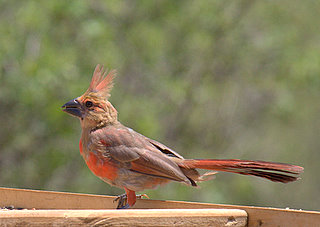- Cardinalis cardinalis
Identification
Length: 7.75 inches
All ages and sexes have a crest and large, conical bill
Male
All red with black mask and chin. Wings have some gray. Orange bill
Female
Brown overall with some red in wings, face, and tail. Red bill
Juvenile
Similar to female but bill is dark instead of red.
Distribution
United States and Mexico.
Taxonomy
Subspecies
There are 18 subspecies[1]:
- C. c. superbus: Extremese California to Arizona, south-western New Mexico and northern Sonora
- C. c. seftoni: Central Baja California (south to latitude 27°N)
- C. c. igneus: Southern Baja California (north to latitude 27°N)
- C. c. clintoni: Isla Cerralvo (Gulf of California)
- C. c. townsendi: Isla Tiburón (Sea of Cortés) and adjacent coastal Sonora
- C. c. affinis: Western Mexico (south-eastern Sonora to south-western Chihuahua and western Durango)
- C. c. sinaloensis: Coastal western Mexico (Sinaloa and Jalisco)
- C. c. mariae: Tres Marías Islands (off western Mexico)
- C. c. carneus: (Long Crested) Coastal western Mexico (Colima to Isthmus of Tehuántepec)
- C. c. cardinalis: Eastern US
- C. c. floridanus: South-eastern Georgia and peninsula Florida
- C. c. magnirostris: South-eastern Texas and southern Louisiana
- C. c. canicaudus: Western Oklahoma and western Texas to east-central Mexico
- C. c. coccineus: Eastern Mexico (eastern San Luis Potosí, Veracruz, north-eastern Puebla and n Oaxaca)
- C. c. littoralis: Lowlands of eastern Mexico (southern Veracruz and Tabasco)
- C. c. yucatanicus: South-eastern Mexico (Yucatán Peninsula)
- C. c. flammiger: South-eastern Mexico (southern Quintana Roo), Belize and Petén of northern Guatemala
- C. c. saturatus: Cozumel Island (off Quintana Roo)
Habitat
Suburban Woodlands and parks, mixed forests and forest edges, back yards, high desert.
Behaviour
Winter flocks can be very large, up to 60 or 70 individuals in areas of abundance.
Diet
Their diet consists mostly of fruit and berries, buds, seeds and flowers, insects being included during the summer.
Breeding
The shallow cup-shaped nest is constructed mainly by the female from twigs, bark, grass and leaves. The clutch consists of 3-4 eggs which are incubated for 12-13 days. The young fledge at about 10 days. The youngsters are generally looked after by the male.
There may be a second brood.
Vocalisation
Song: a clear whistling song. Females will sing along with the male.
It appears there may be varying accents in different localities.
References
- Clements, J. F., T. S. Schulenberg, M. J. Iliff, D. Roberson, T. A. Fredericks, B. L. Sullivan, and C. L. Wood. 2016. The eBird/Clements checklist of birds of the world: v2016, with updates to August 2016. Downloaded from http://www.birds.cornell.edu/clementschecklist/download/
- Cornell
- BF Member observations
- psu.edu
Recommended Citation
- BirdForum Opus contributors. (2024) Northern Cardinal. In: BirdForum, the forum for wild birds and birding. Retrieved 26 April 2024 from https://www.birdforum.net/opus/Northern_Cardinal
External Links






